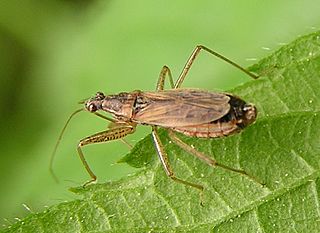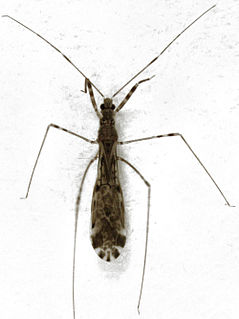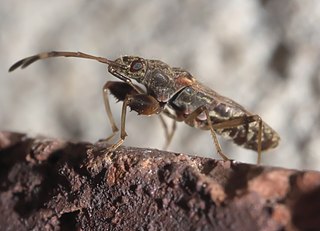
The insect family Nabidae contains the damsel bugs. There are over 500 species in 20 genera. They are soft-bodied, elongate, winged terrestrial predators. Many damsel bugs catch and hold prey with their forelegs, similar to mantids. They are considered helpful species in agriculture because of their predation on many types of crop pests.

Delphacidae is a family of planthoppers containing about 2000 species, distributed worldwide. Delphacids are separated from other "hoppers" by the prominent spur on the tibia of the hindleg.

The Cassidae are a taxonomic family of medium-sized, large, and sometimes very large sea snails commonly called helmet snails or bonnet snails. These are marine gastropod mollusks in the superfamily Tonnoidea and the clade Littorinimorpha.

The thick-billed lark or Clotbey lark is a species of lark in the family Alaudidae.

Turbinellidae are a family of sea snails, marine gastropod mollusks in the clade Neogastropoda. Members of this family are predators.

Machaerotidae are a family of bugs in the superfamily Cercopoidea which were formerly grouped with the other cercopids. They are sometimes called as tube-forming spittle-bugs as the nymphs form a calcareous tube within which they live. These bugs are mainly found in the Old World tropics. The adults of many genera have a long, free and spine-like process originating at the scutellum and thus superficially similar to the tree-hoppers, Membracidae. Its tegmen or forewing, like typical bugs of the suborder Heteroptera, always has a distinct, membranous apical area.

Cassis, common name the helmet shells, is a genus of very large sea snails, marine gastropod mollusks in the family Cassidae, the helmet shells and their allies. This is the type genus of the subfamily Cassinae.

Ploiariolini is a tribe of thread-legged bugs, comprising 16 genera and 142 described species. Ploiariolini has a worldwide distribution.

Emesopsis is a genus of tropical bugs (Heteroptera) from the family Reduviidae. There are at least 22 described species, of which one, E. nubila, also occurs in southern Europe.
Bagauda is a genus of thread-legged bug in the Emesinae. 18 species are currently known. Many of the species of this genus are associated with caves, some exclusively so. Bagauda is synonymous with the genus Pleias Kirkaldy, 1901, but Bagauda has become more widely used. The genus is restricted to Old World tropics.

Flatidae are a family of fulgoroid planthoppers. They are cosmopolitan in distribution and are distinguished from others in the superfamily by a combination of characters. Like all other planthoppers, they suck phloem sap of plants. Some species are known to communicate with vibrations through the plant stems. Communication may be with mates, or with ants that tend the nymphs, protecting them and gathering honeydew secretions. Adults of some species have brightly coloured forewings which are tougher and known as tegmina unlike the membranous hindwings which are used for flight. Although a few can be identified by their coloration, most species requires dissection and examination under a microscope with access to literature on already described species.

Cicadetta is a genus of generally small-bodied annual cicadas widespread across portions of the Palearctic, Oriental, and Ethiopian realms. In older scientific and taxonomic literature, this genus was popularly referred to as Melampsalta. These cicadas occur in a diverse spectrum of habitats, although most taxa are typically associated with weedy meadows and tallgrass prairie ecosystems. Several related species from North America were recently transferred to the genus Cicadettana.

Macrotristria is a genus of cicada in the cryptotympanini tribe of the Cicadinae subfamily. Twenty five species are listed in the Atlas of Living Australia.

Ledrinae is a relatively small subfamily within the very large and diverse leafhopper family Cicadellidae. Originally placed in its own family, the "Ledridae", it is based on the type genus Ledra.

Deraeocorinae is a subfamily of plant bugs in the family Miridae. There are more than 40 genera and around 500 described species in Deraeocorinae.
Buenoa is a genus of backswimmer. It was created by George Willis Kirkaldy in 1904 to include all species of Anisops from the Western Hemisphere with a two-segmented front tarsus in males, reserving the latter genus for Eastern Hemisphere species with a one-segmented front tarsus in males. It contains 69 described species.

Neopamera is a genus of dirt-colored seed bugs in the family Rhyparochromidae. There are about 16 described species in Neopamera.

Oncopeltus is a genus of seed bugs in the family Lygaeidae. There are at least 40 described species in Oncopeltus.

Rhyparochromus is a genus of dirt-colored seed bugs in the family Rhyparochromidae. There are more than 40 described species in Rhyparochromus.

Hemisphaerius is a genus of bugs in the family Issidae and tribe Hemisphaeriini. Species resemble the closely related Gergithus: but are differentiated in this genus by the size of the frons and shorter legs.

















